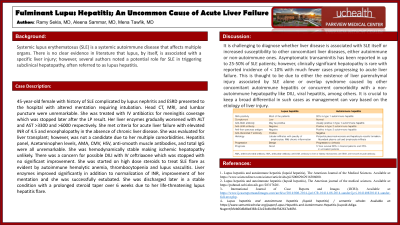Monday Poster Session
Category: Liver
P3137 - Fulminant Lupus Hepatitis: An Uncommon Cause of Acute Liver Failure
Monday, October 28, 2024
10:30 AM - 4:00 PM ET
Location: Exhibit Hall E

Has Audio
- RS
Ramy Sekla, MD
Parkview Medical Center
Pueblo, CO
Presenting Author(s)
Ramy Sekla, MD1, Aleena Sammar, MD2, Mena Tawfik, MD2
1Parkview Medical Center, Pueblo, CO; 2Parkview Health Center, Pueblo, CO
Introduction: Systemic lupus erythematosus (SLE) is a systemic autoimmune disease that affects multiple organs. There is no clear evidence in literature that lupus, by itself, is associated with a specific liver injury; however, several authors noted a potential role for SLE in triggering subclinical hepatopathy, often referred to as lupus hepatitis.
Case Description/Methods: 45-year-old female with history of SLE complicated by lupus nephritis and ESRD presented to the hospital with altered mentation requiring intubation. Head CT, MRI, and lumbar puncture were unremarkable. She was treated with IV antibiotics for meningitis coverage which was stopped later after the LP result. Her liver enzymes gradually worsened with ALT and AST >3300 and >6000 respectively. She met criteria for acute liver failure with elevated INR of 4.5 and encephalopathy in the absence of chronic liver disease. She was evaluated for liver transplant; however, was not a candidate due to her multiple comorbidities. Hepatitis panel, Acetaminophen levels, AMA, CMV, HSV, anti-smooth muscle antibodies, and total IgG were all unremarkable. She was hemodynamically stable making ischemic hepatopathy unlikely. There was a concern for possible DILI with IV ceftriaxone which was stopped with no significant improvement. She was started on high dose steroids to treat SLE flare as evident by autoimmune hemolytic anemia, thrombocytopenia and lupus vasculitis. Liver enzymes improved significantly in addition to normalization of INR, improvement of her mentation and she was successfully extubated. She was discharged later in a stable condition with a prolonged steroid taper over 6 weeks due to her life-threatening lupus hepatitis flare.
Discussion: It is challenging to diagnose whether liver disease is associated with SLE itself or increased susceptibility to other concomitant liver diseases, either autoimmune or non-autoimmune ones. Asymptomatic transaminitis has been reported in up to 25-50% of SLE patients; however, clinically significant hepatopathy is rare with reported incidence of < 10% with much fewer cases progressing to acute liver failure. This is thought to be due to either the existence of liver parenchymal injury associated by SLE alone or overlap syndrome caused by other concomitant autoimmune hepatitis or concurrent comorbidity with a non-autoimmune hepatopathy like DILI, viral hepatitis, among others. It is crucial to keep a broad differential in such cases as management can vary based on the etiology of liver injury.
Disclosures:
Ramy Sekla, MD1, Aleena Sammar, MD2, Mena Tawfik, MD2. P3137 - Fulminant Lupus Hepatitis: An Uncommon Cause of Acute Liver Failure, ACG 2024 Annual Scientific Meeting Abstracts. Philadelphia, PA: American College of Gastroenterology.
1Parkview Medical Center, Pueblo, CO; 2Parkview Health Center, Pueblo, CO
Introduction: Systemic lupus erythematosus (SLE) is a systemic autoimmune disease that affects multiple organs. There is no clear evidence in literature that lupus, by itself, is associated with a specific liver injury; however, several authors noted a potential role for SLE in triggering subclinical hepatopathy, often referred to as lupus hepatitis.
Case Description/Methods: 45-year-old female with history of SLE complicated by lupus nephritis and ESRD presented to the hospital with altered mentation requiring intubation. Head CT, MRI, and lumbar puncture were unremarkable. She was treated with IV antibiotics for meningitis coverage which was stopped later after the LP result. Her liver enzymes gradually worsened with ALT and AST >3300 and >6000 respectively. She met criteria for acute liver failure with elevated INR of 4.5 and encephalopathy in the absence of chronic liver disease. She was evaluated for liver transplant; however, was not a candidate due to her multiple comorbidities. Hepatitis panel, Acetaminophen levels, AMA, CMV, HSV, anti-smooth muscle antibodies, and total IgG were all unremarkable. She was hemodynamically stable making ischemic hepatopathy unlikely. There was a concern for possible DILI with IV ceftriaxone which was stopped with no significant improvement. She was started on high dose steroids to treat SLE flare as evident by autoimmune hemolytic anemia, thrombocytopenia and lupus vasculitis. Liver enzymes improved significantly in addition to normalization of INR, improvement of her mentation and she was successfully extubated. She was discharged later in a stable condition with a prolonged steroid taper over 6 weeks due to her life-threatening lupus hepatitis flare.
Discussion: It is challenging to diagnose whether liver disease is associated with SLE itself or increased susceptibility to other concomitant liver diseases, either autoimmune or non-autoimmune ones. Asymptomatic transaminitis has been reported in up to 25-50% of SLE patients; however, clinically significant hepatopathy is rare with reported incidence of < 10% with much fewer cases progressing to acute liver failure. This is thought to be due to either the existence of liver parenchymal injury associated by SLE alone or overlap syndrome caused by other concomitant autoimmune hepatitis or concurrent comorbidity with a non-autoimmune hepatopathy like DILI, viral hepatitis, among others. It is crucial to keep a broad differential in such cases as management can vary based on the etiology of liver injury.
Disclosures:
Ramy Sekla indicated no relevant financial relationships.
Aleena Sammar indicated no relevant financial relationships.
Mena Tawfik indicated no relevant financial relationships.
Ramy Sekla, MD1, Aleena Sammar, MD2, Mena Tawfik, MD2. P3137 - Fulminant Lupus Hepatitis: An Uncommon Cause of Acute Liver Failure, ACG 2024 Annual Scientific Meeting Abstracts. Philadelphia, PA: American College of Gastroenterology.
